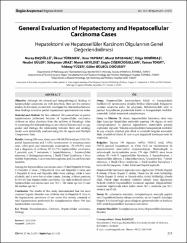| dc.contributor.author | Başsüllü, Nuray | |
| dc.contributor.author | Türkmen, İlknur | |
| dc.contributor.author | Yaprak, Onur | |
| dc.contributor.author | Dayangaç, Murat | |
| dc.contributor.author | Demirbaş, Tolga | |
| dc.contributor.author | Güler, Necdet | |
| dc.contributor.author | Bülbül Doğusoy, Gülen | |
| dc.date.accessioned | 2014-12-31T08:59:27Z | |
| dc.date.available | 2014-12-31T08:59:27Z | |
| dc.date.issued | 2011 | |
| dc.identifier.citation | Bassullu N, Turkmen I, Yaprak O, Dayangac M, Demirbas T, Guler N, Uraz S, Akyildiz M, Cigerogullari ME, Tokat Y, Yuzer Y, Bulbul Dogusoy G. General evaluation of hepatectomy and hepatocellular carcinoma cases. Turk Patoloji Dergisi. 2011; 27(3): 221-229. doi: 10.5146/tjpath.2011.01079. | en_US |
| dc.identifier.issn | 1018-5615 | en_US |
| dc.identifier.uri | http://www.turkjpath.org/text.php3?doi=10.5146/tjpath.2011.01079 | en_US |
| dc.identifier.uri | https://hdl.handle.net/11446/639 | en_US |
| dc.description | İstanbul Bilim Üniversitesi, Tıp Fakültesi. | en_US |
| dc.description.abstract | Objective: Although the clinical and histopathological findings of hepatocellular carcinoma are well described, there are few national studies. In this study, we aimed to investigate the relationship between these findings in total or partial hepatectomy specimens in our series.
Material and Method: We first collected 190 cases of total or partial hepatectomies performed because of hepatocellular carcinoma, cirrhosis or other disorders from the archives of Pathology. After re-examining the histopathological and clinical features such as age, gender and etiology, the relationship between them and serology results were statistically analyzed using the chi square and Multiple Comparison Tests.
Results: Among 190 cases, there were 168 (88.5%) total and 18 (9.5%) partial hepatectomies and 4 (2%) tumorectomy or metastasectomy cases. After gross and microscopic examination, 170 (89.5%) cases had a diagnosis of cirrhosis, 85 (44.7%) hepatocellular carcinoma, 3 parasitic cyst, 7 metastasis, 1 hepatoblastoma, 1 hepatocellular adenoma, 2 cholangiocarcinoma, 2 Budd Chiari Syndrome, 1 focal nodular hyperplasia, 1 cavernous hemangioma, and 2 acute fulminant hepatitis.
Among the hepatocellular carcinoma cases, 53 had Hepatitis B virus, 15 Hepatitis C virus , 3 Hepatitis B virus and Hepatitis C virus, and 3 Hepatitis B virus and Hepatitis delta virus etiology, while 6 were alcoholic and 4 were due to other causes. Among cirrhosis patients, 84 (49.4%) had hepatocellular carcinoma. The male to female ratio of hepatocellular carcinoma cases was 74/11. The mean age was 55 and the median age 56.7.
Conclusion: The results of this study demonstrated that the most common hepatic disorder was cirrhosis due to Hepatitis B virus in the hepatectomy specimens of our series that mostly consisted of total hepatectomies performed for transplantation where 50% had hepatocellular carcinoma. | en_US |
| dc.language.iso | eng | en_US |
| dc.publisher | Turkish Federation of Pathology Societies | en_US |
| dc.rights | info:eu-repo/semantics/openAccess | en_US |
| dc.subject | transplantation | en_US |
| dc.subject | cirrhosis | en_US |
| dc.subject | hepatocellular carcinoma | en_US |
| dc.subject | etiology | en_US |
| dc.title | General evaluation of hepatectomy and hepatocellular carcinoma cases | en_US |
| dc.title.alternative | Hepatektomi ve hepatosellüler karsinom olgularının genel değerlendirilmesi | en_US |
| dc.type | article | en_US |
| dc.relation.journal | Türk Patoloji Dergisi / Turkish Journal of Pathology | en_US |
| dc.department | DBÜ, Tıp Fakültesi | en_US |
| dc.identifier.issue | 3 | en_US |
| dc.identifier.volume | 27 | en_US |
| dc.identifier.startpage | 221 | en_US |
| dc.identifier.endpage | 229 | en_US |
| dc.contributor.authorID | TR26265 | en_US |
| dc.contributor.authorID | TR183371 | en_US |
| dc.contributor.authorID | TR123080 | en_US |
| dc.contributor.authorID | TR100576 | en_US |
| dc.relation.publicationcategory | Belirsiz | en_US |


















